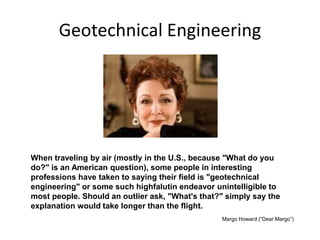Geotheta - The Facts
Geotheta - The Facts
Blog Article
What Does Geotheta Mean?
Table of ContentsSee This Report on GeothetaThe 10-Second Trick For GeothetaGeotheta - TruthsGeotheta - The FactsLittle Known Facts About Geotheta.

They carry out website investigations, collect samples, execute lab tests, and analyze data to examine the viability of the ground for construction jobs - Consulting Engineer. Based on their findings, geotechnical engineers provide referrals for foundation style, incline stability, preserving structures, and reduction of geotechnical risks. They collaborate with other professionals, such as architects, structural designers, and construction teams, to make sure that geotechnical factors to consider are integrated into the overall task layout and execution
By analyzing the behavior and residential properties of soil and rock, they can determine potential geotechnical hazards such as landslides, dirt negotiation, or incline instability. Their knowledge helps protect against failures or crashes that can threaten lives and home. Right here are some in-depth duties and obligations of a geotechnical designer: Site Investigation: Geotechnical designers conduct website investigations to gather data on subsurface conditions.
They analyze the data to understand the properties and actions of the dirt and rock, including their strength, leaks in the structure, compaction features, and groundwater conditions. Geotechnical Analysis and Design: Geotechnical engineers analyze the information gathered throughout website examinations to assess the security and viability of the website for building and construction tasks. They perform geotechnical estimations and modeling to evaluate aspects such as bearing capacity, negotiation, incline security, side earth stress, and groundwater flow.
The Definitive Guide for Geotheta
Foundation Layout: Geotechnical designers play a vital function in creating structures that can securely sustain the intended framework. They assess the dirt conditions and tons demands to identify the suitable foundation type, such as superficial foundations (e.g., grounds), deep foundations (e.g (https://trello.com/u/geotheta)., piles), or specialized techniques like dirt renovation. They take into consideration aspects such as settlement restrictions, bearing capability, and soil-structure communication to develop optimal foundation layouts
They assess building and construction plans, monitor website activities, and conduct area examinations to verify that the layout recommendations are complied with. If unanticipated geotechnical issues arise, they analyze the situation and give suggestions for remediation or changes to the layout. Danger Analysis and Reduction: Geotechnical engineers evaluate geotechnical dangers and dangers connected with the project website, such as landslides, liquefaction, or dirt disintegration.

Collaboration and Interaction: Geotechnical designers function carefully with various other specialists associated with a project, such as designers, architectural designers, and building and construction teams. Reliable communication and cooperation are important to integrate geotechnical factors to consider right into the general project layout and building process. Geotechnical engineers give technological proficiency, response questions, and guarantee that geotechnical needs are met.
Facts About Geotheta Revealed
Right here are some kinds of geotechnical engineers: Foundation Engineer: Structure designers specialize in developing and analyzing foundations for structures. They assess the soil problems, load demands, and site features to identify the most ideal structure kind and layout, such as superficial foundations, deep foundations, or specialized methods like pile foundations.
They evaluate the variables influencing slope stability, such as dirt residential or commercial properties, groundwater conditions, and incline geometry, and develop techniques to avoid slope failures and reduce risks. Earthquake Designer: Earthquake designers concentrate on analyzing and making frameworks to withstand seismic forces. They analyze the seismic hazard of a website, examine soil liquefaction potential, and create seismic layout requirements to guarantee the security and resilience of structures throughout earthquakes.
They perform field screening, accumulate samples, and examine the gathered information to define the soil residential or commercial properties, geologic formations, and groundwater problems at a site. Geotechnical Instrumentation Engineer: Geotechnical instrumentation engineers concentrate on monitoring and measuring the actions of soil, rock, and frameworks. They set up and preserve instrumentation systems that keep track of factors such as dirt negotiation, groundwater degrees, incline movements, and architectural variations to evaluate efficiency and give early warnings of possible concerns.
Geotheta Things To Know Before You Buy
They carry out examinations such as triaxial tests, combination examinations, direct shear tests, and leaks in the structure tests to gather information for geotechnical evaluation and style. Geosynthetics Engineer: Geosynthetics designers concentrate on the layout and application of geosynthetic materials, such as geotextiles, geogrids, and geomembranes. They utilize these products to boost dirt stability, enhance slopes, give drain options, and control disintegration.
They often tend to be investigative people, which suggests they're intellectual, introspective, resource and investigative. They wonder, methodical, sensible, logical, and sensible. Several of them are likewise social, meaning they're kind, generous, cooperative, individual, caring, handy, empathetic, skillful, and pleasant. Does this noise like you? Take our free profession examination to learn if geotechnical designer is just one of your leading profession suits.
In the office setting, geotechnical engineers use specialized software tools to do calculations, develop designs, and evaluate information. They prepare reports, review task specs, communicate with clients and employee, and coordinate project tasks. The office setup gives a favorable environment for research, evaluation, and cooperation with other experts included in the job.
5 Simple Techniques For Geotheta
They often visit task websites to conduct site examinations, assess geotechnical problems, and gather data for evaluation. These sees entail taking a trip to different places, occasionally in remote or challenging surfaces. Geotechnical designers may perform dirt tasting, conduct examinations, and display building and construction activities to make certain that the geotechnical aspects of the task are being executed appropriately.
Geotechnical engineers also work in specialized geotechnical laboratories. Geotechnical laboratory designers function thoroughly in these atmospheres, taking care of screening tools, running instruments, and tape-recording data.
Report this page